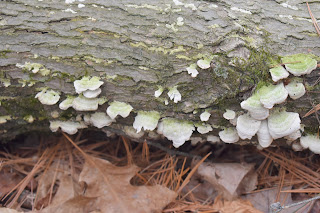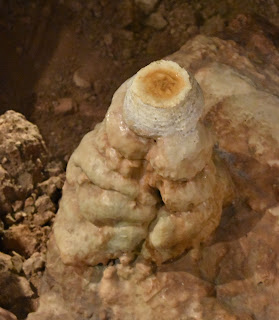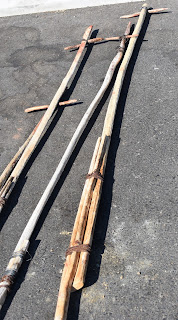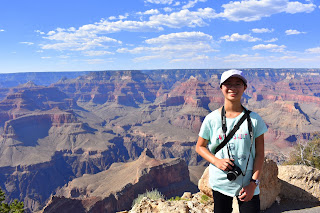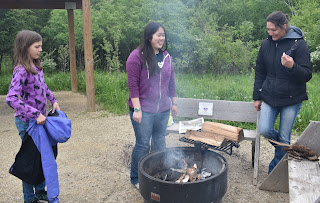In 2017, I pared back my nature goals a bit to the ones that I feel are realistic and meaningful to me. I'm making progress thanks to a recent trip to Arizona where Olivia and I traveled from Tucson (southern Arizona) to the Grand Canyon (northern Arizona) and back while Sophia was at a leadership camp in Patagonia, Arizona.
1.
Take 6 new hikes.
So far I have taken 5 out of 6 new hikes for the year.
FIRST HIKE
Went to
Pine Point Regional Park in Stillwater, Minnesota, on Sunday, March 26th.
I have never been to this park nor had I ever heard of it.
Two geese flew up from the pond.
They are in the upper right part of the photo.
It was a bit chilly - only 37 degrees out.
The trail led down to a pond area where there were a few beaver lodges.
There were some moss clumps on the side of the trail which were interesting to see.
Also found out that this park is at the end of the Gateway State Trail which goes from Stillwater to St. Paul.
It also links up with the Brown Creek Trail. It looks like a nice paved road for those who enjoy riding bikes; or want to run or walk.
At this time of the year there isn't a tremendous amount of things to see. However, there was a hole in one of the trees.
It was more near the base than in the middle or upper section. Wondered if it was a woodpecker or other bird that made the hole.
SECOND HIKE
On Thursday, March 30th, I went to
Wind in the Pines in Scandia, Minnesota. According to the website about the park:
Wind in the Pines Park is thought to be one of the most diverse ecological areas left in Washington County by the Minnesota DNR. This 44-acre site is located in the northeast corner of the Township along State Highway 95 across from Pilar Road.
Bounded by the Falls Creek SNA to the north and the Lower St. Croix National Scenic Riverway to the east, this parcel offers diversity of old growth forest and pristine prairies- providing invaluable wildlife habitat and unparalleled scenic value.
We were going to hike there once, but had the dogs with us. Dogs are not allowed in the park, so we weren't able to hike there. On the 30th, I didn't have the dogs with me and it was a nice day - in the 50s.
Took a hike on the main pathway since I was unfamiliar with the park and no one knew I was there. At any rate, it was a nice, peaceful hike.
Although I didn't see any wildlife, I heard crows around in the prairie area. Further into the woods, there was an owl.
It was a nice break from the day, and a glimpse into this beautiful parcel of land.
I'd like to go back again later this spring and see how the park look once the trees fill in.
I didn't go on any hikes from April through the end of June due to a foot injury (micro-tears in my tendon of the second toe in my left foot).
THIRD HIKE
Although my foot
still isn't healed, I wanted to go on some hikes while in Arizona. The first one was on Monday, July 3rd at the
Arizona Sonora Desert Museum. Unlike most museums, about 85% of the experience is outdoors.
The 98-acre Desert Museum is a unique experience. It combines a zoo, botanical garden, art gallery, natural history museum, and aquarium into one experience. There are 21 interpreted acres with two miles of walking paths through various desert habitats, 230 animal species, and 1,200 types of plants (with more than 56,000 specimens).
On the day we visited, it started out in the upper-80s. By the time we were done, it was in the low 100s.
There was some wildlife out - like this Zebra-Tailed Lizard. When it is frightened, it runs away with its tail curled up over its back. The black and white tail is much more visible and eye-catching at that point.
There were some birds too - including this Gila Woodpecker that was eating the fruit of the saguaro cactus.
Although not in the wild, this bighorn sheep was one of many of a herd in an enclosure that replicated the high, rocky cliffs it liked.
There were many varieties of cacti at the Arizona Sonora Desert Museum. There were some with colorful blossoms and flowers.
Another part of the hike had a garden area devoted to plants for pollinators. They were very colorful and vibrant - a sharp contrast to the predominant colors of the desert. This is a Red Bird of Paradise.
There was a hummingbird enclosure at the museum. There was a pathway that wound around plants and feeders designed for hummingbirds. This one is a Broad-Billed Hummingbird.
FOURTH HIKE
The fourth hike I went on was a short one since I had the boot on my left foot for support. This was taken on July 4th on our way to Saguaro National Park. The view of the desert was beautiful from our vantage point.
The path was very rocky and narrow.
Olivia did better than me with climbing. She could have continued for much longer than me.
The boot definitely made it much more challenging to walk.
FIFTH HIKE
The fifth hike I went on was on July 7th at Taliesin West - a home and studio that Frank Lloyd Wright designed that's in Scottsdale, Arizona.
The property is surrounded by desert plants and lots of dry soil and rocks. It's in sharp contrast to the grassy areas that are closer to the home and studio.
At any rate, on the tour, we saw a chain fruit cholla which is a shrubby cactus. It has many segmented, irregular, drooping branches. These are covered with a dense layer of sharp spines.
If you look closely, there are two nests in the cactus. They belong to the Cactus Wren - Arizona's state bird.
As we looked around, there were a variety of different types of vegetation.
The neat thing was that there were quail that were running between the bushes and cacti. We saw both adults and babies.
2.
Assist as needed with the Wildlife Project Bowl team for our 4-H Club which includes reading 6 nature books or publications.
I attended all the weekly meetings from the first week in January through mid-March in preparation for the regional Project Bowl. The team was undefeated and placed first in the region!
The team before one of the competitions.
The opposing team sat in four desks and
had buzzers just like our team.
They are advancing to the state level on April 8th and we are meeting weekly from March 23rd-April 6th.
The team with their first-place medals.
Olivia and Sophia are to the far right.
During the first seven weeks of practices, I did not sit in with Sophia (who was coaching the team again this year). After that point, I sat in on meetings to see how the team was doing and suggest what they needed to concentrate on to prepare for the competition.
In terms of reading, this year I concentrated on reading and writing questions from two publications:
Woodworking for Wildlife and
Landscaping for Wildlife.
I asked two other parents to read and write questions for the six
Minnesota Conservation Volunteer magazines. It was good to delegate and spread the work load among the parents.
I skimmed through the
Minnesota Conservation Volunteer magazines, but did not read them as in depth as during the past two years when we've done the Wildlife Project Bowl.
Since I didn't thoroughly read six publications, I thought I'd pick four more wildlife/animal/nature books to read during the rest of the year. I read
Animal Dialogues back in March and April which I enjoyed.
3.
Visit 5 state parks that I’ve never seen.
So far I have visited 2 out of 5 new state parks this year.
AFTON STATE PARK (MINNESOTA)
The first state park I went to this year was Afton State Park. The girls and I went camping there on May 18th-19th. There had been a lot of rain, so the creek leading to the river was rather muddy.
The St. Croix River, however, was a beautiful blue. Quite a contrast.
Sophia and Olivia enjoyed visiting Afton State Park too; and going on hikes.
While we were camping, we went on three hikes. One was to the river (pictured above). Another was in the forest behind the yurt.
The third was in a prairie.
KARTCHNER STATE PARK (ARIZONA)
The second state park I visited this year was Kartchner State Park in Arizona. The main attraction here is a cave. You are not allowed to touch anything in the cave (or it will damage it) or take photos.
So, there were some replicas of formations that you could see in the cave in the visitor center. The one below is a "fried egg" stalagmite (a formation found on the ground of a cave - versus the ceiling - that is typically wider than they are tall).
Another type of formation that we saw a lot of was "soda straws." They are very thin and long stalactites that have an elongated cylindrical shape rather than the more conical shape of stalactites.
One of the fun highlights while we were waiting for the cave tour to start was seeing a raven. They are big birds! This one flew right in front of Olivia as she was walking on a pathway. We sat near where it landed and it seemed to want to have its picture taken.
4.
Visit 4 nature centers that I haven’t visited before.
So far I have visited 3 out of 4 nature centers this year.
NATURE CENTER AT KARTCHER STATE PARK
The first nature center that I visited was at Kartchner State Park. There were informative displays about caves and bats.
One part had three different openings that people could go through that simulated what narrow openings there are in caves. Some that the founders of this cave had to crawl through were much narrower than the one Olivia is going through (pictured below). They had exhale so as to reduce their body size. In that way, they could fit through some of the openings.
One of the things that I learned was that the 86,000 year old remains of a Shasta Ground Sloth were found in the cave in 1995.
According to the BBC, “The Shasta ground sloth is like no animal alive today. It was about the size of a cow and had shaggy reddish brown fur. It had a long neck and relatively small head. A very large stout tail and powerful hind legs enabled it to rear up and reach leaves on shrubs and trees. Its legs were built in such a way that it would have walked with a waddling motion using the outer sides of its hind feet and the knuckles on its front feet.”
Typically, a Shasta Ground Sloth would not live inside a cave because of a lack of food. However, this particular one could have been injured; or was looking for shelter or food.
GEOLOGY MUSUEM/NATURE CENTER AT GRAND CANYON NATIONAL PARK
One of the stops we made while at the Grand Canyon was the Geology Museum. There were displays that showed the different layers of rocks that we were seeing as we looked out at the Grand Canyon.
Another display explained the time periods that each of the layers of rock formed.
What was particularly interesting was a display that showed the Grand Canyon in its entirety and where the South Rim was in relationship to the canyon as a whole.
There were some of the viewing points marked on the display which helped give a perspective about what we were looking at and the vastness of the Grand Canyon.
We went to the main Visitors Center twice while at the Grand Canyon. In addition to displays (which were rather difficult to see because of the number of people there), there was a short film on a revolving globe in one section. It talked about and illustrated the history of the Grand Canyon from more of an exploratory/tourism aspect.
There also was a movie on the other side that we watched. The auditorium had two quotes on the wall.
Between reading the quotes and looking at the preview for the movie, the waiting time went by quickly.
The movie was well done and very interesting.
We watched it after we had spent two days going on hikes, taking photos, and riding the shuttle buses throughout the national park. The movie was a good way to end our visit to Grand Canyon.
5.
See 4 National Parks, Forests, and/or Monuments; and/or Reservations.
I have met and exceeded this goal by visiting 8 National Parks, Forests, and/or Monuments; and/or Reservations.
NATIONAL MONUMENT
Montezuma Castle (Camp Verde, AZ)
On July 6th, we saw one of the best preserved cliff dwellings in North America.
It is a 20 room high-rise apartment, nestled into a towering limestone cliff. It is about five stories tall.
According to the NPS site, Montezuma Castle, "...tells a story of ingenuity, survival and ultimately, prosperity in an unforgiving desert landscape."
The displays and visitor center illustrated the Sinagua culture and what life was like for the people who lived there then quite well.
Next to the trail were trees that were leafed out, yet did not appear to have any bark (like the rough bark that is typically seen in Minnesota). It's an Arizona Sycamore tree.
We also were seeing a lot more grasses - albeit dry, tan-colored grass - in this part of Arizona.
There were many informational signs along the pathway that noted the names of plant and if they had a special purpose. This was very helpful - particularly for us to know the names of plants we had been seeing during our trip to Arizona.
National Parks:
- Saguaro National Park (Tucson, AZ)
Tucson, Arizona, is home to the nation's largest cacti: the giant saguaro. These plants are found only in a small portion of the United States, and are protected by Saguaro National Park.
There are two parks: east and west. We chose to explore the western Saguaro National Park after hearing there were more cacti at the west one. There also were more opportunities to get out and explore at the western part of the park.
Olivia and I went on a couple of hikes at Saguaro National Park. To get to the hikes, we drove on unpaved roads through one section of the park. It was rather rugged and quite different than I pictured a national park to be.
There was an interpretive walk that Olivia and I went on that explained some of the plants we were seeing and more about desert life. Before we went on the walk, we were fortunate to meet a Native American family who had just finished harvesting some of the saguaro fruit. There is only one tribe that is allowed to do that, so we were happy to have been able to cross paths with them.
They harvest the fruit from the saguaro. It's fair-sized and covered with seeds.
They encouraged us to take one to taste. They were - for the most part - sweet. It was kind of like eating fruit leather, except they were a bit more stickier. The seeds reminded me of poppy seeds.
The fruit grows beneath the white flower.
The fruit also made juice which tasted like fresh strawberries that had been mashed down. It was sweeter than the fruit itself.
They harvest the fruit by using long poles that are made from the ribs of saguaro cacti that have died.
On the ground we could seed the fruit pods that were emptied.
The trail we went on was full of desert plants.
Being that it was close to 100 degrees, there wasn't a lot of wildlife - just some birds near the cacti.
One plant that we kept seeing a lot of was the one pictured below. Found out it was a creosote bush.
A short walk that we took within Saguaro National Park was to Signal Hill. There were petroglyphs on some of the rocks there.
The trail was very rugged and rocky. There's Olivia up on the trail - much further than I am. It's that boot that's slowing me down.
The climb was rather steep.
We had to be very aware of our surroundings - rattlesnakes lived in the rocks adjacent to the pathway.
Once we got to the top, we saw the petroglyphs.
There were quite a few circular images.
One our way back down, I had Olivia stand by another type of cactus. It's good to get a size comparison because sometimes a picture doesn't show how big or small something is. Olivia is close to five feet tall - so the cactus was pretty tall and wide.
Some cacti have colorful fruits and blossoms on them.
This saguaro made me laugh. It looked like it had arms and a super long neck and head.
It was, in a way, a desert version of the scary woods that Dorothy, the Lion, the Scarecrow, the Tinman, and Toto went through
- Grand Canyon National Park (Grand Canyon, Arizona)
On July 5th and 6th, I saw the Grand Canyon...finally. At 51 years old, I can finally say I've seen this amazing colorful and impressive geologic formation.
The canyon is 277 river miles long; and is up to 18 miles wide and one mile deep. I could read facts like this and conceptually understand them. However, it's not until I saw the Grand Canyon that its immensity and history sank in.
Olivia and I visited the South Rim of the park Each stop was so different from the others. There were steep cliffs.
Incredible views.
Layers upon layers of rock formations dotted with vegetation.
One of the highlights of our time there happened on the way out of the park. We saw a mother and three young elk in the forest. The babies had their white spots on them still - a method of camouflage.
There were two other elk eating the leaves off some small trees. They were unafraid of people.
The next day the squirrels were out in force. There was one that we enjoyed watching eat a pinecone.
The pinecones were sticky, on the small side, and green.
I picked a couple of pinecones so Olivia could give it to a squirrel. Needless to say, this was a highlight of the Grand Canyon experience for her.
The squirrel would eat a pinecone and come back to her.
The sunlight was so bright when we were there that many pictures seemed washed out. So, I tried to switch from color to black and white to see the difference. I like the black and white version for this photo below.
One of the last stops we made was on the east side of the South Rim of the Grand Canyon. We went back on a pathway away from others who had got off the shuttle bus. Our trek was worth it. Found an intriguing tree.
Also found a secluded path (though obviously walked on by others) that led to many beautiful views of the canyon.
We both thought it would be great to come back again during a different (cooler) season as well as during different times of the day (early morning and evening) to see how the sun would change the colors of the rock formations.
National Forests:
- Coconino National Forest (Arizona)
Coconino is the third largest national forest in Arizona (1.85 million acres) that extends over mountains, plateaus, and canyons.
It is in the center of the state and features the San Francisco Peaks north of Flagstaff, the red rocks of Sedona, and several forested lakes.
One of the features that we liked about this forest was Lava River Cave that we visited on July 5th. It may be hard to tell in the photo below, however, the cave is a one-entry/one-exit cave that is quite long.
The entrance is very rocky with large boulders and rocks that we had to climb over.
Different parts of the cave had different types of terrain - some was relatively smooth (like in the photo below) while others had jutting rocks, wide splits, or uneven ground.
By the time that we reached the middle of the cave, it was pitch black. Thankfully, we had headlamps (as well as two more sources of light for each of us - just in case). The only way I was able to get photos of the cave was by turning on the flash on the camera.
We accidently went the wrong way in the cave when there was a split in the pathway. If we had seen the left passageway, we would have gone the easier way. Instead, we both only saw the right passageway: the more difficult one.
As you can see, Olivia is crouched down in order to get through this way so we could continue exploring the cave.
It went on for a bit and then we crawled out. We turned around to make sure we knew what the opening looked like that we had come from so we would know where to go back when we were ready to leave.
Thankfully, Olivia noticed the arrows that were pointing in different directions. The one pointing up indicated the route we needed to go back on.
Towards the end of the experience, I know I was getting tired and not consuming enough water. I was getting lightheaded and dizzy. Then my shoe got stuck in a rock. Of course, it was my left shoe - the foot that hurts from the micro-tears to the tendons.
It was a vigorous and fascinating experience - one unlike we have ever had. When we left the cave, we headed back out on the dirt road. The shoulders were rather steep.
As we continued through the forest, we came across wandering cows. We had seen signs for cows and this was the first time we had the opportunity to see them.
We were so excited! You would think we had never seen a cow before. These had horns - which different than the kind we typically see in Minnesota.
- Kaibab National Forest
There are actually three units of the Kaibab National Forest.
The part that we saw borders the South Rim of the canyon. It is land which is tree-covered in the higher elevations near the rim but becomes flat and grassy further south.
We saw lots of signs telling us to be aware of wildlife. This is one sign telling us we were entering an area where there were deer. (As a side note, we didn't see deer in this forest.)
- Prescott National Forest
This forest is in central Arizona and covers a lot of mountainous land. Cities that we went through that are in the forest include Prescott and Camp Verde. The scenery in this forest is varied with parts of the Sonoran Desert in it as well as chaparral, pine-juniper sections, and ponderosa pine forests at the highest elevations.
This section had a sign that we don't see in Minnesota: a watch-out-for-elk sign.
One of the types of trees we saw in this section was Catclaw Mimosa. The sign was at Montezuma's Castle.
This is the Catclaw Mimosa tree:
Another fun sign that we saw was a watch-out-for-wild-burros sign.
We never saw any. It would have been pretty exciting for us to see wild burros crossing the road.
-
San Xavier
This is the smaller part of the Tohono O’odham Nation, and is where Mission San Xavier del Bac is located.
Outside of the Mission, there was a little cactus garden that led to a shrine that was filled with lit candles.
The cacti are all so different from one another.
They have different shapes, flowers, and blossoms.
-
Gila River (from Tucson on the way to Phoenix).
We passed through the area, but didn't stop. There's interesting information about the
history of the area and the impact that the Spanish had on Native residents.
6.
Do 1 entry per month in my nature journal. For some of those entries, identify and journal about 3 new types of wildlife and/or birds.
Each month I've done at least one nature journal entry - so 3/3 months of success!
I did one entry in
January, two entries in
February, and four entries in
March.
For the second quarter of 2017, I did:
- one entry in
April about wrens; and
- one entry in
May about barred owls.
I'm still working on finishing three entries for June about brown thrashers, black bears, and birds that I saw during the month. May just skip the months of July through September rather than trying to catch up.
For October, I'd like to write about the Spicebush Swallowtail Butterfly caterpillar that Olivia spotted yesterday. This type of butterfly only lives in two counties in Minnesota - and ours is one of them. We were super excited to see one of these caterpillars that we've never seen before.
7.
Go on a camping trip.
We went camping in a yurt at Afton State Park on May 18-19.
One of the features that we liked about the yurt is that it has a wood-burning fireplace.
There are two bunkbeds on one side and another bunkbed on the other side.
We took walks around the park, and near the visitor center we saw a Chimney Swift house.
The flowers were blooming along the river.
The St. Croix River was beautiful and clear.
We had dinner over a campfire.
We made fresh lemonade with honey. It was a bit on the tart side, but still good.
We had dessert over the campfire as well: s'mores, at the girls' request.
The next day, we took two hikes. One was through a forested area.
We saw lots of tracks - from smaller animals to large animals (like deer).
We went on a walk through a prairie and then came back to make lunch. We had some trouble starting the fire. I guess 4-Hers aren't known for their fire-building skills like the Boy Scouts or Girl Scouts are.
We had a quick and filling lunch - including fruit pizza for dessert.
The base of the "pizza" was a watermelon slice. The toppings were different types of fruit.
We all agreed that we would want to come back to this park and the yurt again...and maybe stay for more than one night.
8.
Plant on our nature trail 10 trees and shrubs that are native to Minnesota.
We have not moved forward with this goal yet. The nature trail is quite overgrown at this point - with some grasses in the 2-3 foot tall range. I'm not sure it's the best use of financial resources to try to keep mowing a path and planting trees on this part of the farm. However much it would be nice to have a wider diversity of trees and shrubs, it would require annual upkeep with mowing the path (ideally weekly). Trying to cut, spray, and put bark chips down would be cost prohibitive for us.
I need to give this some more thought and see if there may be another way to approach this goal.
9.
Attend 4 workshops, classes, or activities at state parks.
Olivia and I went caving in Arizona (see photos above). However, I was thinking of more local workshops, classes, and activities at Minnesota State Parks. I was hoping to do some activities this summer at some state parks, but I never got around to it. The classes during the late winter and fall are limited. Looks like I won't be able to reach this goal.
10.
Have 6 picnics when the weather is pleasant and we aren't battling with mosquitoes.
Our first picnic was on June 27th in the backyard. Sophia suggested we have a picnic because it was a nice evening. We had a pasta dinner using some of the produce from the CSA.
We had thought that we were going to do some picnics while traveling through Arizona. However, the 110+ degree heat was a bit too much to be comfortable outside. In fact, one day we got ice cream cones from Dairy Queen. During the short distance from the air-conditioned Dairy Queen to our car, the ice cream melted a lot. Even sitting in the air-conditioned car didn't help the cone from melting faster than we could keep up with it. So, no outdoor eating in Arizona.
We haven't had any more picnics as a family since the one in June. We've been dealing with a lot of wasps and hornets this year - especially in our backyard and around the house. It makes eating inside all that more attractive and safe.




















